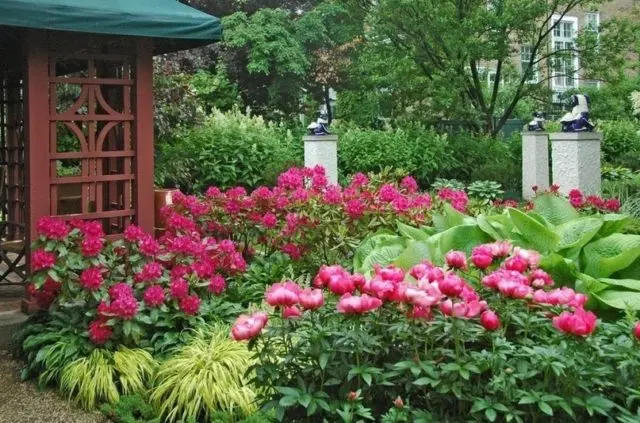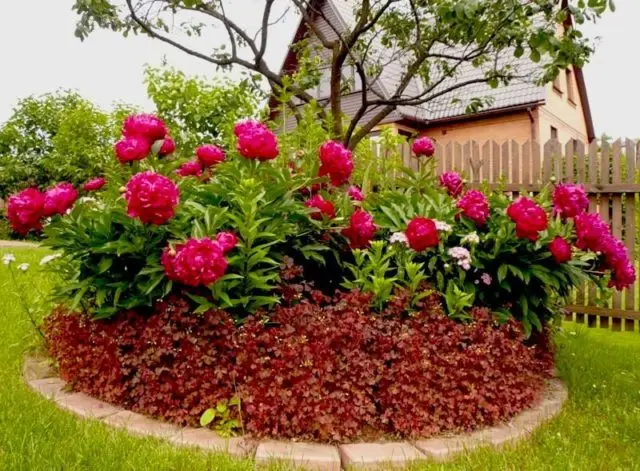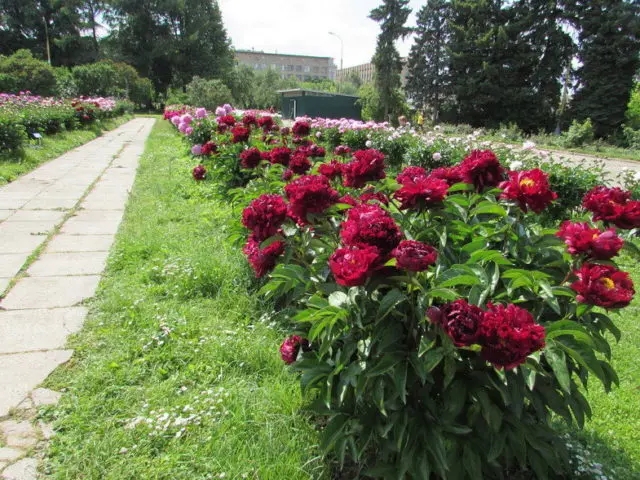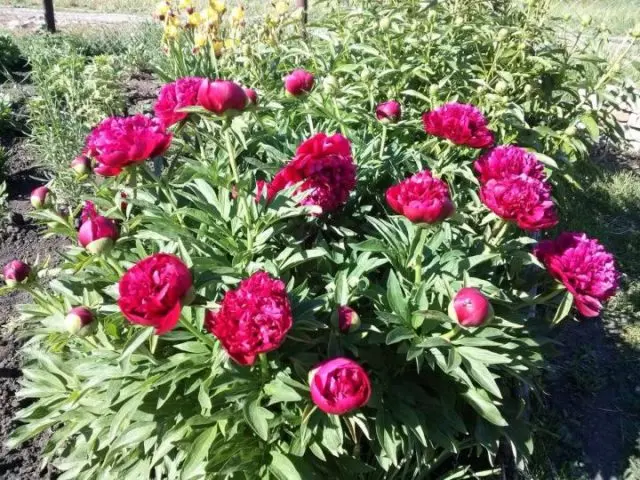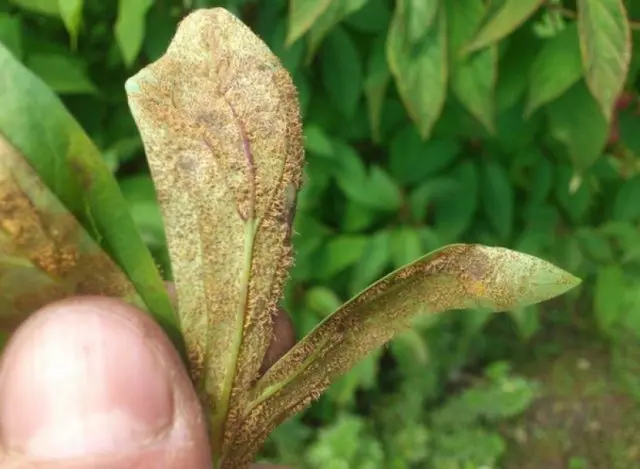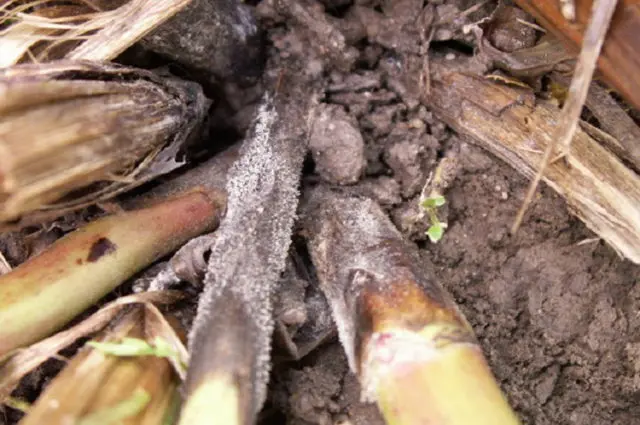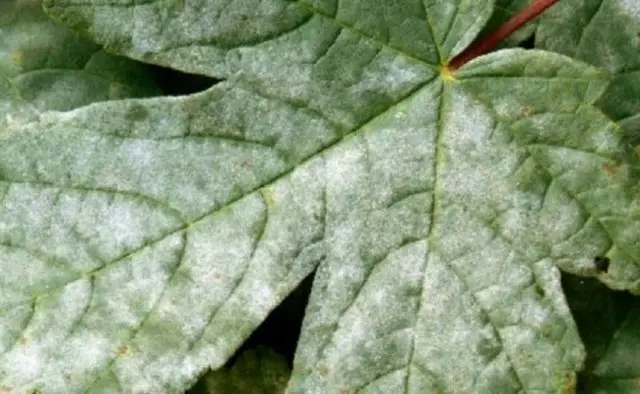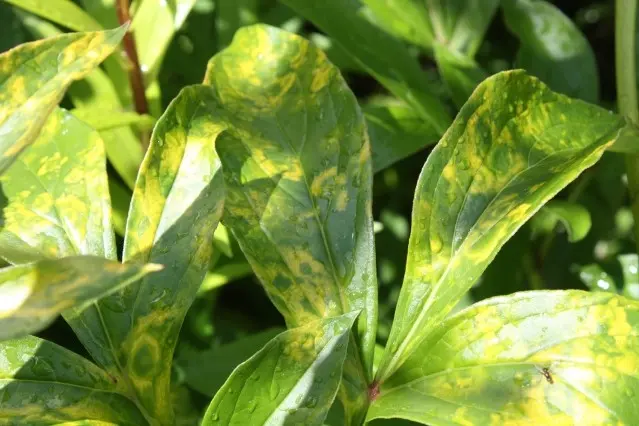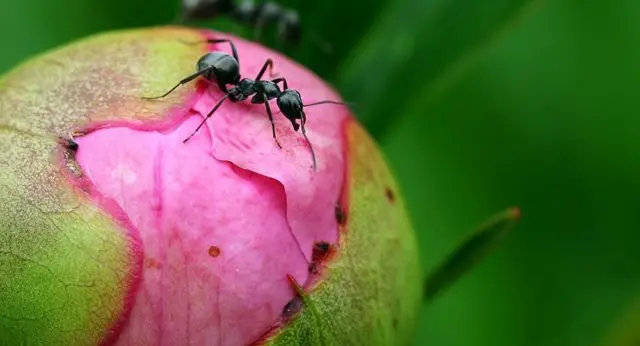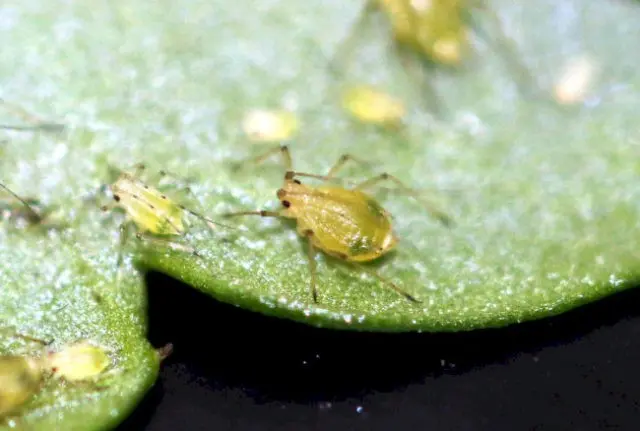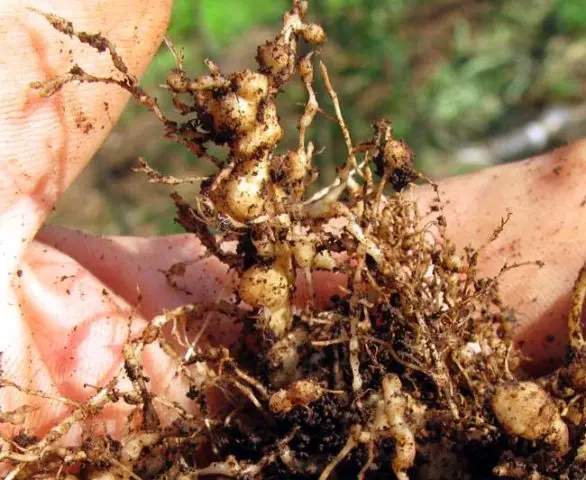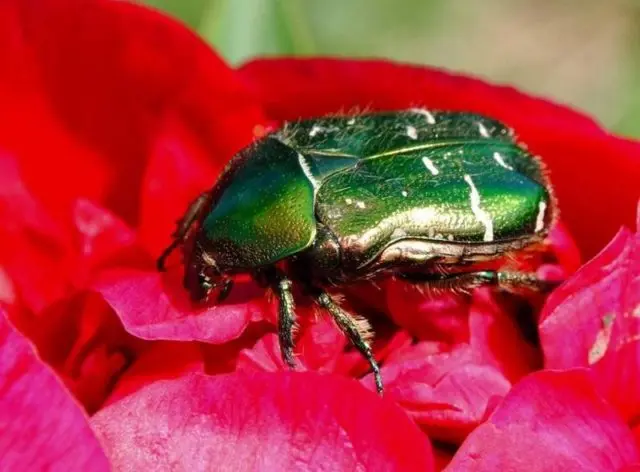Contents
- Benefits of growing burgundy peonies
- The best varieties of burgundy peonies
- Moscow
- Julia Drunina
- Vladimir Novikov
- Nikolay Vavilov
- Paul M. Wild
- Karen Gray
- Red Spider
- America
- Angelo Cobb Freeborn
- Shima-Nishiki
- Red Grace
- Lastres
- Scarlet Sails
- Akron
- Oslo
- Qiao sisters
- Black Panther
- Felix Supreme
- Armani
- Kansas
- Black Pearl
- Highlight
- Sword Dance
- Peter Brand
- dragon flowers
- Red Sharm
- Henry Boxtos
- Chokelite Soulde
- The use of burgundy peonies in design
- Planting and caring for burgundy peonies
- Diseases and pests
- Conclusion
Burgundy peonies are a very popular variety of garden flowers. There are many varieties, and to choose the most beautiful of them, you need to get acquainted with brief descriptions.
Benefits of growing burgundy peonies
Burgundy peonies are represented by a wide varietal diversity, however, against the background of other varieties, they can be considered few. There are several advantages to growing flowers in a rich dark shade:
- rare color. The selection of burgundy varieties is associated with certain difficulties, therefore, among the abundance of white and red peonies, burgundy varieties in summer cottages can not be found so often. A blooming perennial with a rich dark shade is guaranteed to attract the attention of guests.
- Lush flowering. During the period of maximum decorativeness, peony bushes look very beautiful, large flowers on them are located in a heap, close to each other.
- large buds. In most varieties, the size of the buds is 15-25 cm in diameter, even dwarf burgundy peonies bring flowers that are large compared to the general dimensions.
- Brightness. It is the burgundy varieties that look most spectacular on the garden plot, they stand out against any background.
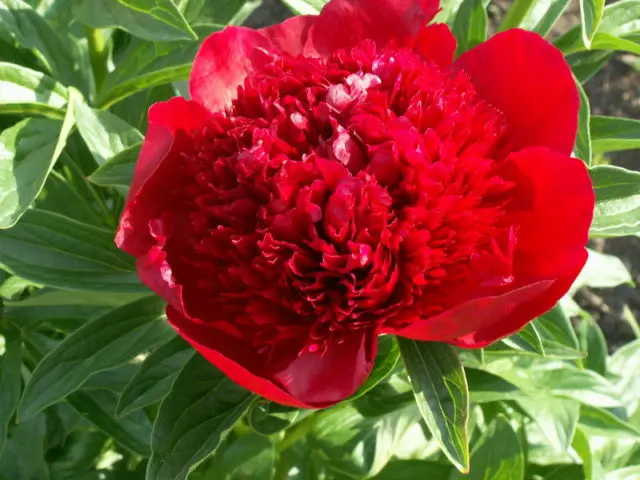
Burgundy peonies bloom in early June
The advantages of burgundy varieties can also be attributed to early flowering. Most varieties bloom as early as June and decorate the garden with beautiful bright flashes, some varieties begin to bloom at the end of May.
The best varieties of burgundy peonies
Among the most popular varieties, several varieties of burgundy peonies can be listed. They differ mainly in size, the difference is in the shades of flowering and the dimensions of the inflorescences.
Moscow
A miniature variety of burgundy peony with stems up to 50 cm tall. Produces large, deep ruby buds with long yellow staminodes, or antherless stamens. The diameter of the buds reaches 10 cm. The leaves of the plant are rich green, patterned, the variety emits a light delicate aroma.
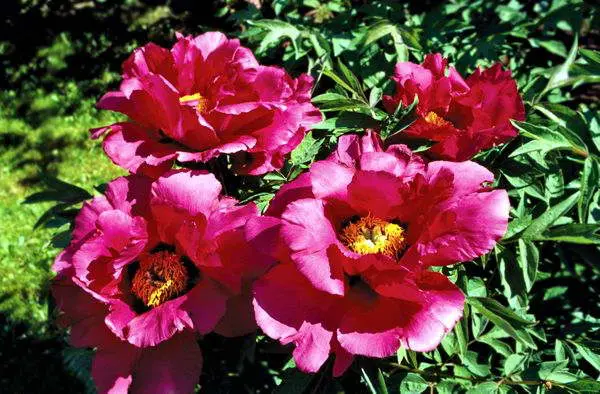
Moscow is suitable for growing in the ground and in flowerpots
Julia Drunina
The hybrid variety belongs to tree peonies and rises up to 1 m above the ground. The bush consists of numerous strong stems, the flowers of the peony are red-burgundy, with a purple spot at the base, with white staminodes and purple-yellow stamens. The buds are quite large, their width can reach 20 cm.
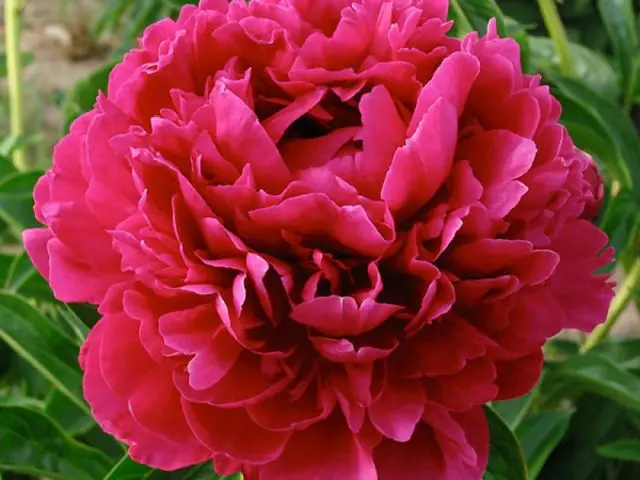
You can recognize the Yulia Drunina variety by a bright dark spot at the base of the flower
Vladimir Novikov
The tree-like variety is able to reach 1,5 m above the ground. Burgundy peony brings large flowers up to 20 cm red-violet, a dark purple stripe runs through the center of the petals. The edges of the petals are ruffled. Raspberry stamens with yellow anthers, burgundy peony emits a strong pleasant smell.
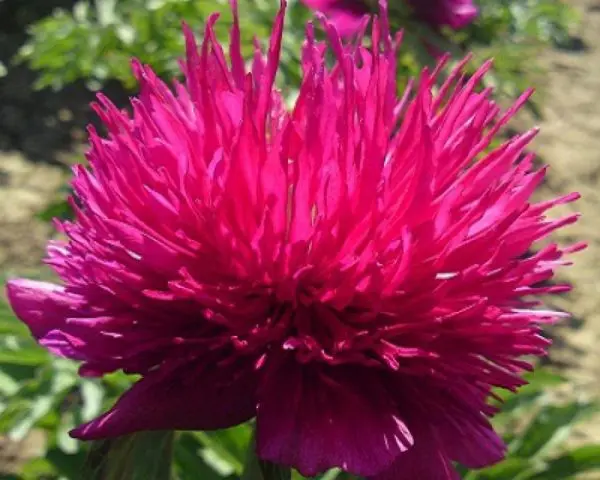
Vladimir Novikov begins to bloom in mid-June
Nikolay Vavilov
Tree-like hybrid variety up to 1 m tall. The flowers of the plant are large, about 20 cm, the petals are arranged in the shape of a bowl. In color, the buds are burgundy-violet, with a darker shade in the middle, and the stamens of the perennial are purple with yellow anthers at the ends. A flower bed with a burgundy peony of this variety looks very bright.
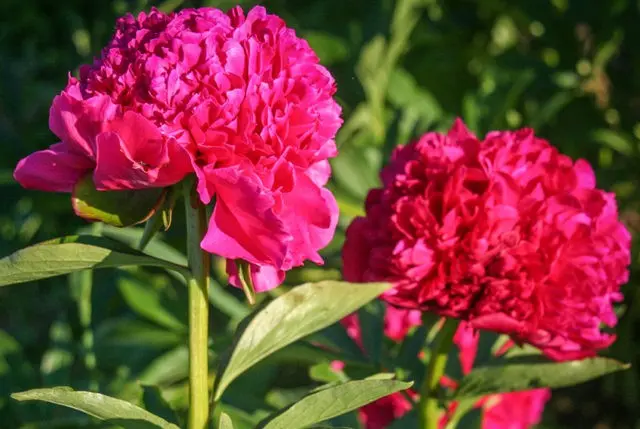
Nikolai Vavilov is highly resistant to drought and fungal diseases
Paul M. Wild
The herbaceous variety rises up to 1 m above the ground and produces semi-double flowers up to 18 cm wide. The color of the buds is burgundy with a slight raspberry tint, the petals are concave in shape and arranged relative to each other, like scales.
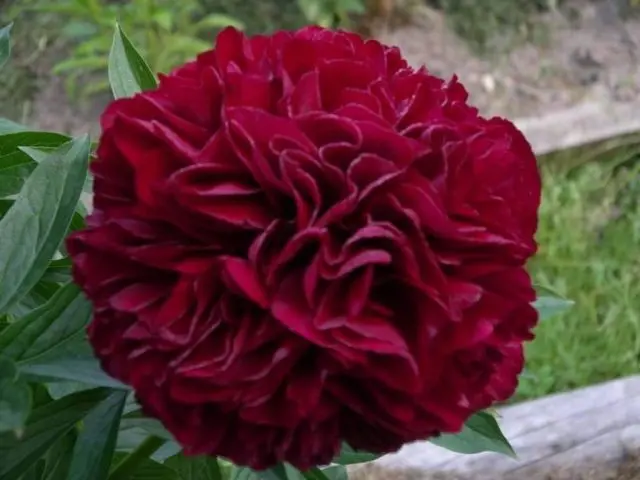
Paul M. Wilde can withstand temperatures down to -40 ° C, it can be grown in Siberia
Karen Gray
Herbaceous peony bush grows up to 70 cm and brings bright maroon flowers up to 16 cm in diameter, anemic in shape. The flowers in the middle are wide pale pink staminodes and yellow stamens, the stems are reddish, with matte dark green leaves. The burgundy peony variety looks decorative not only during flowering, but also after it.
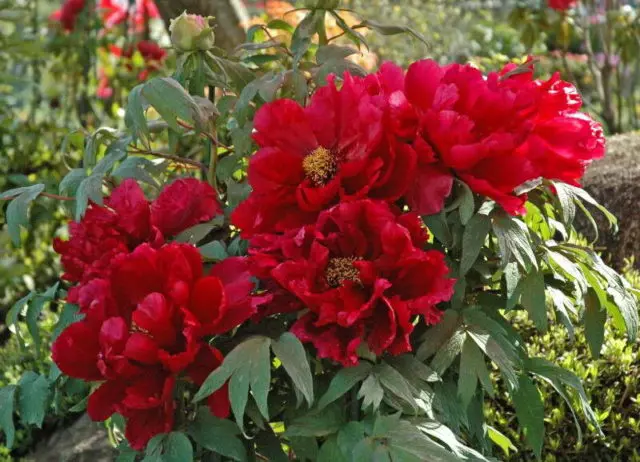
Karen Gray brings not only central but also side buds
Red Spider
The red-burgundy peony belongs to dwarf hybrids – its growth is no more than 50 cm. The flowers of the variety are double, burgundy-raspberry in hue, up to 10 cm wide. The petals are arranged in the shape of a bowl, they are rounded on the outside, and narrow and elongated, fringed in the center. The variety is grown not only in the garden, but also in closed containers.
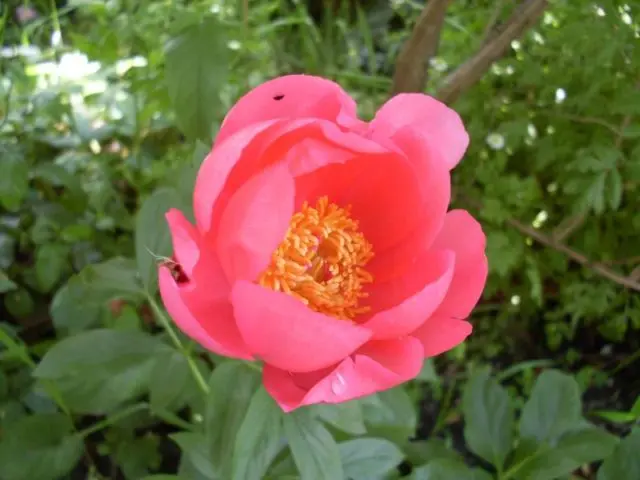
Dwarf Red Spider is well suited for cutting and shaping bouquets
America
Medium-sized garden peony rises to 75 cm and produces large maroon flowers up to 21 cm in diameter. The shape of the flowers is simple, the petals are corrugated, with smooth edges, the shape of the buds resembles tulips. The variety brings up to 4 buds on each of the stems, yellow short stamens are located in the center of the flowers.
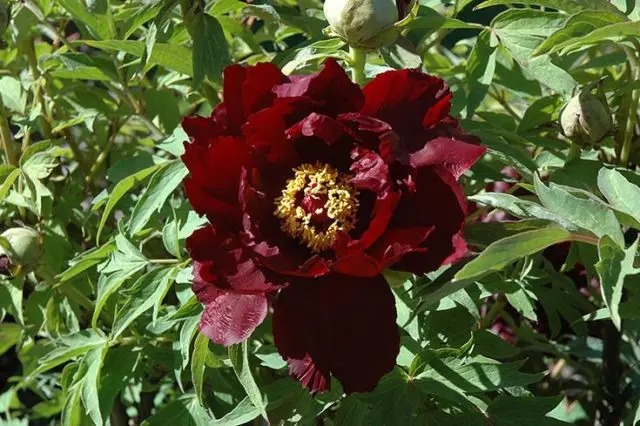
The burgundy America received a gold medal from the American Peony Society in 1992.
Angelo Cobb Freeborn
The hybrid burgundy variety is tall, it rises to 90 cm. It blooms with double flowers of a spherical shape, the color is dark crimson with a faint salmon tint at sunset. In diameter, the buds grow up to 18 cm, exude a pleasant delicate aroma. The plant has pale green leaves and looks very decorative.
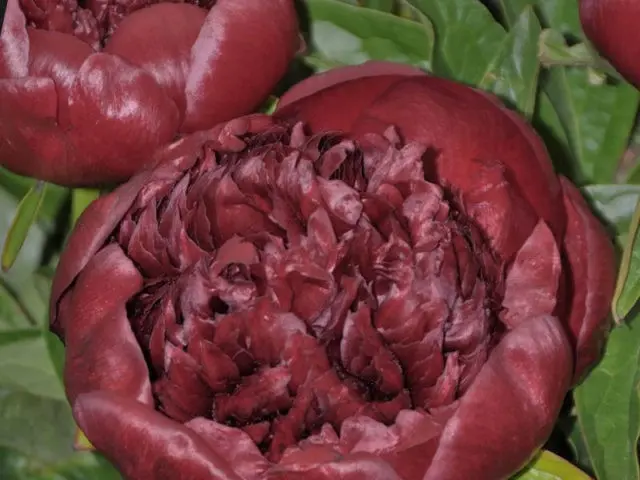
Angelo Cobb Freeborn was bred in America back in 1943
Shima-Nishiki
A tree-like tall variety is able to rise up to 1,5 m above the ground. Peony flowers are semi-double, not only burgundy, but also white-scarlet, and almost white flowers can be located on one bush. The petals are concave and cup-shaped, up to 16 cm in diameter, the leaves are rich green with a noticeable bronze tint.
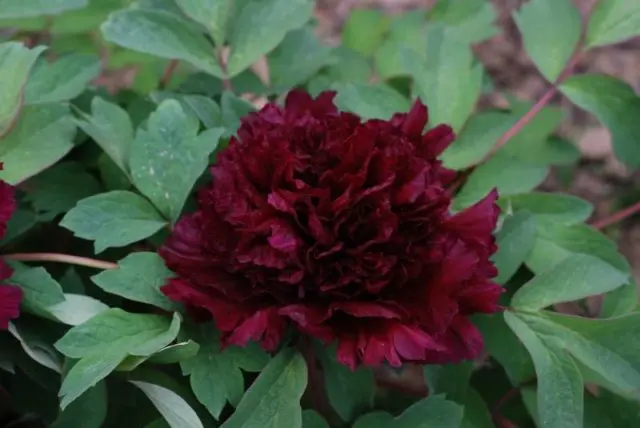
Shima-Nishiki begins to bloom at the end of May
Red Grace
Herbaceous hybrid plant can rise up to 1,2 m above the ground. The flowers of the burgundy peony are double, spherical, dark cherry hue. The diameter of individual flowers reaches 18 cm, the petals are rounded in shape.
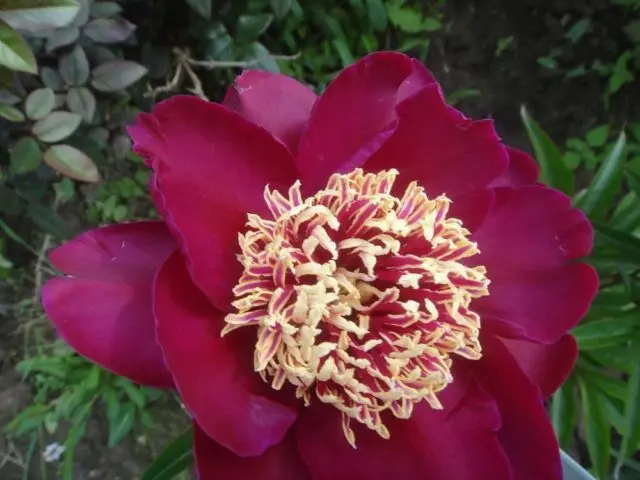
Red Grace produces only central burgundy buds – one on each stem
Lastres
Herbaceous hybrid plant rises up to 70 cm in height. It blooms with semi-double large flowers up to 19 cm each, the buds are rich burgundy in shade with a brick sheen. The stamens in the flowers are yellow, with red veins, the leaves of the plant are light green. Perennial exudes a pleasant light aroma during flowering.
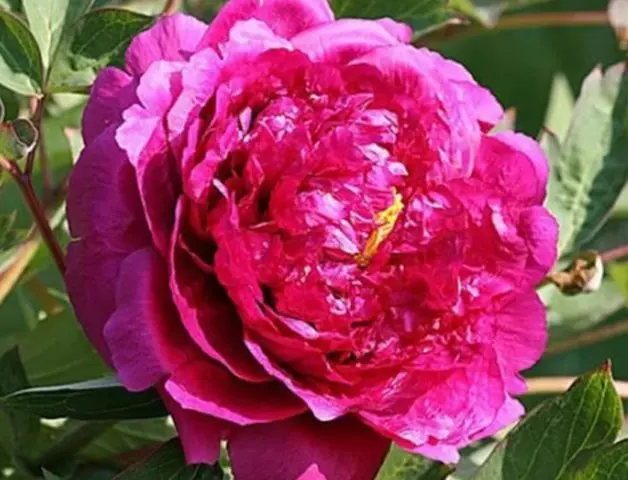
Lastres almost does not fade in the sun and is suitable for planting in open areas.
Scarlet Sails
The tree-like variety of burgundy peony is very large and can rise up to 2 m. The flowers are purple-burgundy in color, a single bush can bring up to 70 flowers. The petals are arranged in the form of a crown, the flowers reach 16 cm in size. The variety has beautiful carved bright green leaves.
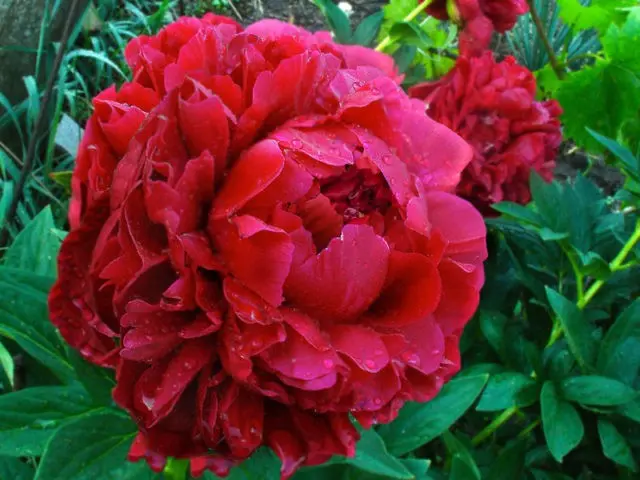
Scarlet sails can produce up to 70 burgundy buds on one bush
Akron
The burgundy peony rises above the ground on average up to 1 m and blooms with large spherical flowers up to 17 cm wide. The flowers are carmine-burgundy in color, with corrugated staminodes crowned with cream tips in the center. The stems of the variety are reddish in color, with long dark green leaves of a decorative shape.
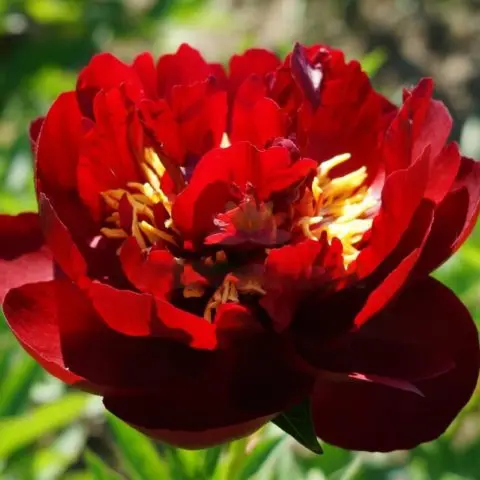
Akron blooms in mid-June and exudes a light fragrance.
Oslo
The dwarf variety of burgundy peony grows no more than 50 cm tall. The flowers of the variety are anemone, burgundy-pink in hue, only about 10 cm in diameter. In the middle of the flowers are large stamens with yellow tips.
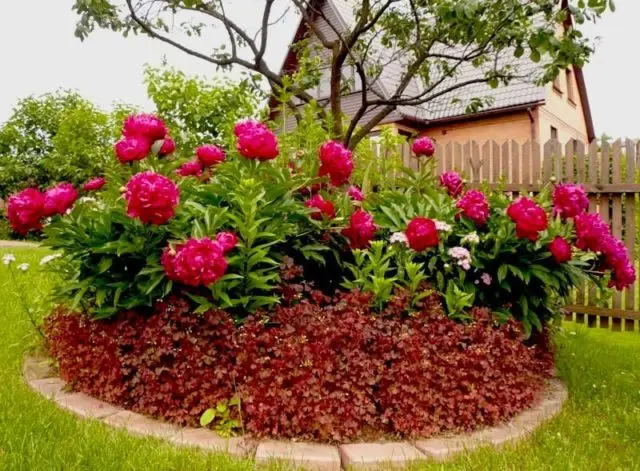
Oslo is suitable for arranging bouquets due to its compact size
A miniature variety is grown both in the ground and in flowerpots. Flowers have a mild pleasant scent.
Qiao sisters
Tall tree-like perennial reaches 1,5 m in height. The pink-burgundy peony brings beautiful semi-double flowers that mix burgundy and white. The dimensions of the flowers are very large – they reach up to 25 cm. The stems of the variety are straight, rigid, do not bend under the weight of the inflorescences, the leaves are large and carved, pale green in color.
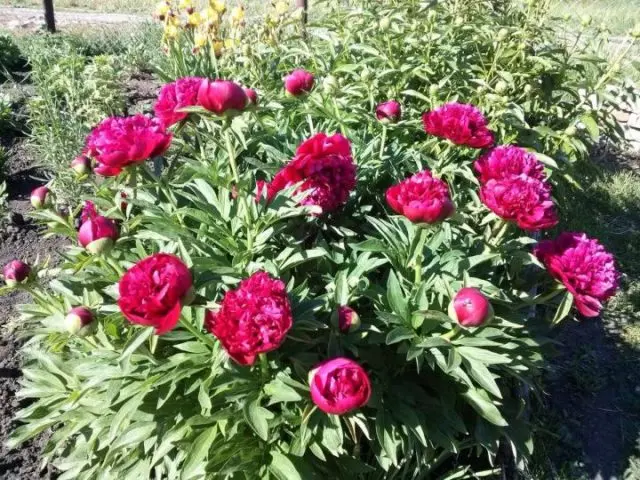
An adult bush of Sister Kiao produces up to 100 burgundy buds
Black Panther
The tree-like maroon peony variety rises up to 1,5 m above the ground and gives semi-double flowers of large sizes – up to 25 cm. The shade of the flowers is very interesting – dark, rich burgundy, with pronounced chocolate tones. The perennial emits a pleasant rich smell, bright green leaves look beautiful against the background of bright flowers.
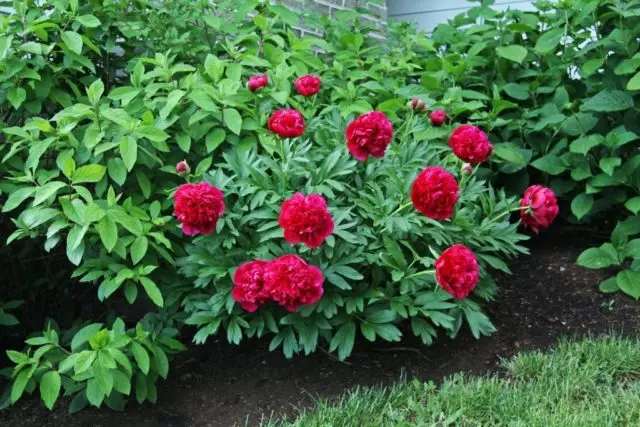
Black Panther can bloom for about 20 years in one place
Felix Supreme
Double burgundy peony grows up to 90 cm above the ground and produces beautiful, rose-like flowers up to 16 cm in diameter each. By shade, the buds are burgundy-violet, with lilac hues. The color of the buds largely depends on the weather, with a sunny color the plant looks brighter, on cloudy days it acquires a rich dark color.
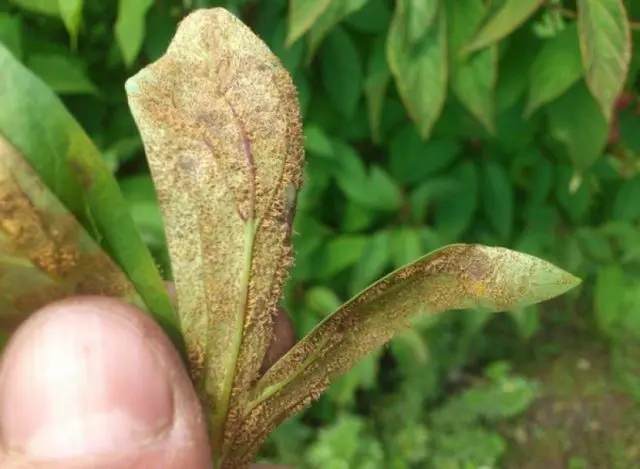
Felix Supreme produces a strong rosehip scent when flowering
Armani
The medium-sized variety rises to 1 m and produces double buds about 23 cm wide. The color of the variety is very rich, dark wine, as the buds develop, the color intensity only increases. The Armani variety has a strong pleasant aroma, and in autumn the peony leaves also acquire a burgundy hue. The plant is considered quite rare.
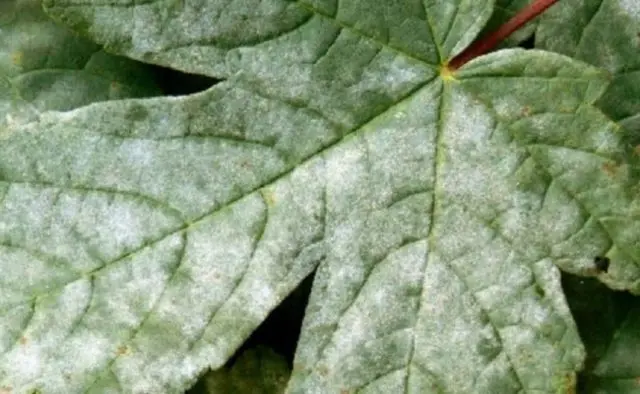
Armani leaves turn deep red in autumn
Kansas
A medium-sized herbaceous perennial rises to 1 m above the ground, and the flowers grow up to 20 cm in diameter. The structure of the buds is strongly double, reminiscent of rose flowers, the petals are very dense. The color of the peony is burgundy-raspberry, it emits a rich sweetish aroma during the decorative period.
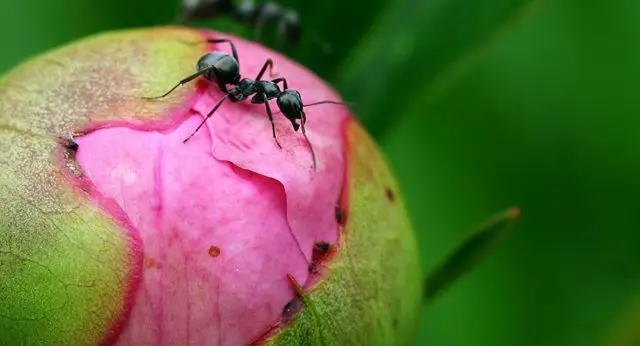
Kansas – 1957 American Peony Society Gold Medal Winner
Black Pearl
Quite rare, but very beautiful variety up to 1 m tall. Brings spherical buds of dark burgundy color with a chocolate tint, opened flowers reach 15 cm and slightly resemble a carnation in shape. It exudes a light pleasant aroma, decorative effect is enhanced by large dark green leaves.
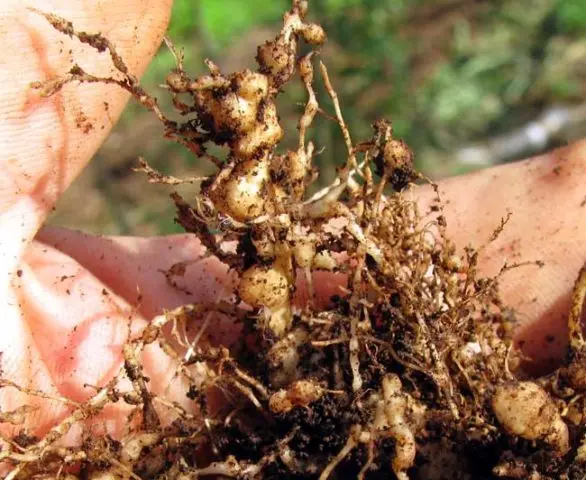
Black pearl blooms at the end of June
Highlight
The herbaceous variety of burgundy peony has a very lush flowering. Highlight brings terry buds on tall, above 1 m, stems, the color of the buds is maroon, similar to tongues of fire.
A distinctive feature of the variety is late flowering. Unlike most burgundy varieties, Highlight does not bloom in June, but only at the end of August.
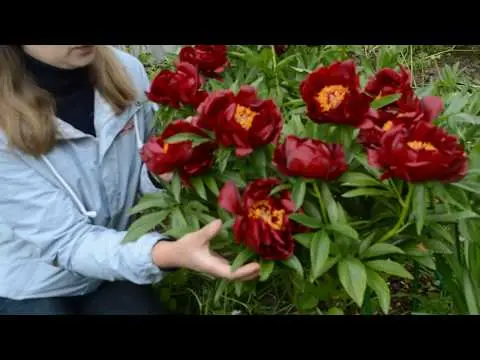
Highlight has drooping stems and may require a garter
Sword Dance
The compact but tall variety rises to 90 cm and has strong, straight stems. It blooms profusely, brings maroon large buds with yellow-reddish staminodes in the center. A feature of the variety is resistance to heat and sunny weather – in illuminated areas on clear days, it does not fade and does not lose color.
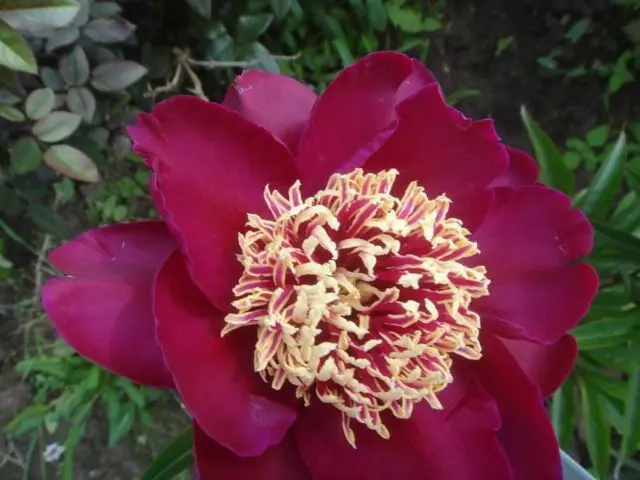
Sword Dance begins flowering in June and early July
Peter Brand
A very old and well-known variety, bred back in the 1930s, reaches a height of 90 cm. The stems of the peony are strong and strong, the leaves are green with a rich color, up to 3 buds grow on each stem. The bloom is burgundy in color, the buds can reach 18 cm in width. The Peter Brand variety is characterized by increased resistance to diseases.
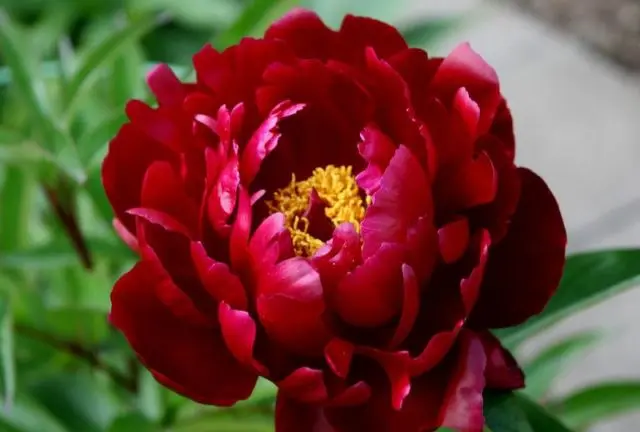
Peter Brand – a variety suitable for growing in partial shade
dragon flowers
A very tall burgundy peony rises up to 2 m above the ground. The buds of the variety are terry, purple-burgundy in color, large – up to 25 cm each, sometimes acquire a purple hue. Bushes bloom very profusely, up to 70 buds can be collected on one plant. A variety of Dragon Flowers has large leaves of bright green color.
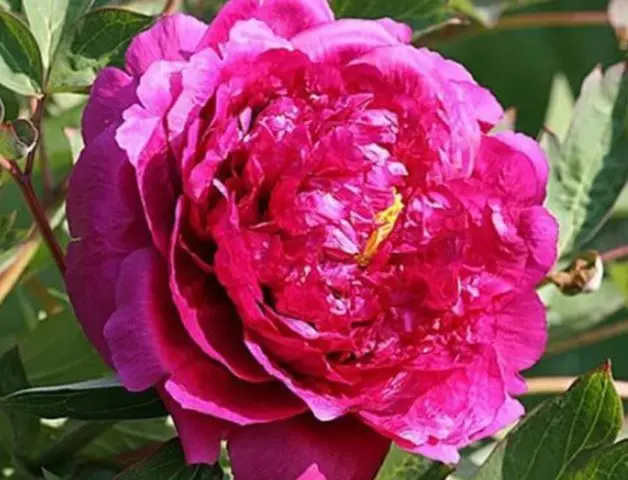
Peony Dragon Flowers retains its decorative effect for 2 weeks
Red Sharm
The hybrid herbaceous variety blooms very early – the buds bloom as early as the end of May. In height, the peony bushes rise by 75 cm, the flowers of the variety are burgundy with a wine tint, closer to autumn their color becomes darker. In width, Red Charm buds grow up to 20 cm, in structure they are terry, spherical in shape.
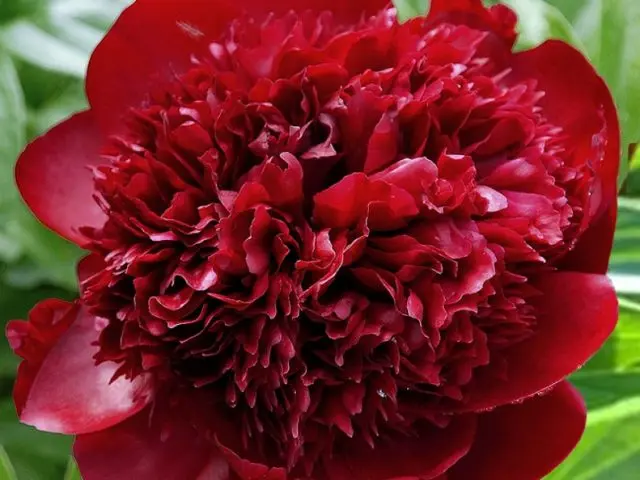
Red Charm leaves turn reddish in autumn
Henry Boxtos
The hybrid burgundy peony is characterized by strong stems about 90 cm tall and light green leaves. The flowers of the plant are maroon, with a noticeable pomegranate tint, terry in structure and reminiscent of rosebuds. The flowers are up to 20 cm wide, slightly fluffy at the ends. The flowering of the variety is dense.
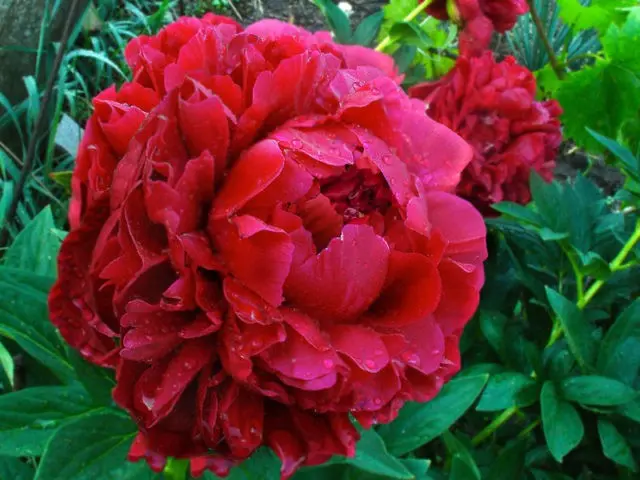
Henry Boxtos fades slightly in direct sunlight
Chokelite Soulde
A medium-sized maroon peony rises an average of 70 cm and brings small buds up to 16 cm each. In color, the flowers of the variety are dark cherry, very beautiful, with chocolate notes, golden “splashes” may be present on the petals. In the center of double and semi-double buds are dark staminodes with yellow tips.
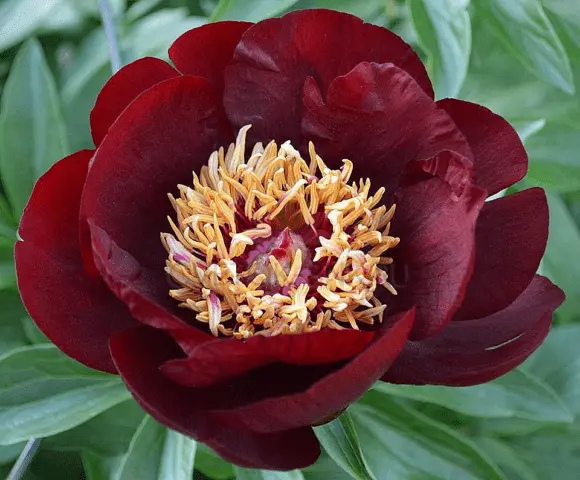
Chokelit Soulde can produce double and semi-double buds on the same bush
Tornado
A fairly high variety grows up to 90 cm. It has strong stems with green leaves, each stem has a burgundy double flower. The diameter of the buds is about 11 cm, yellowish stamens are located in the center. The variety is characterized as resistant to adverse growing conditions, Tornadoes rarely infect diseases.
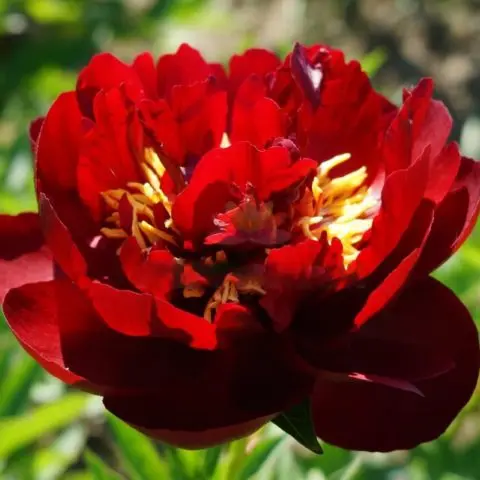
Tornado is convenient because it tolerates drought and poor soils well.
The use of burgundy peonies in design
In the garden landscape, burgundy peonies are used very widely:
- Most often they are planted in areas in the immediate vicinity of the house – on the sides of the porch, near the walls, next to the gazebo. With this arrangement, perennials are clearly visible and also allow you to clearly highlight the site.

Peony bushes draw attention to the selected area
- Burgundy peonies are actively used in front gardens, as part of flower beds and group compositions.

A flower bed with peonies looks lush, even if there are no other plants on it.
- With the help of plants, you can form a small hedge that divides the garden into separate zones.

The hedge of flowers rises low, but attracts the eye
- Peony bushes look beautiful near the fences, they allow you to revive the landscape and cover the empty space.

Peony bushes are often planted near fences so as not to leave wastelands.
Peonies are best combined with lilies, daisies, lupins and phlox. You can plant them next to any perennials that prefer sunny places.
But in the immediate vicinity of tall trees and dense shrubs, it is better not to plant flowers. In this case, strong neighbors take away moisture and nutrients from peonies, which makes flowering less abundant. In addition, against the background of trees and shrubs, flowering burgundy perennials do not look so bright and spectacular.
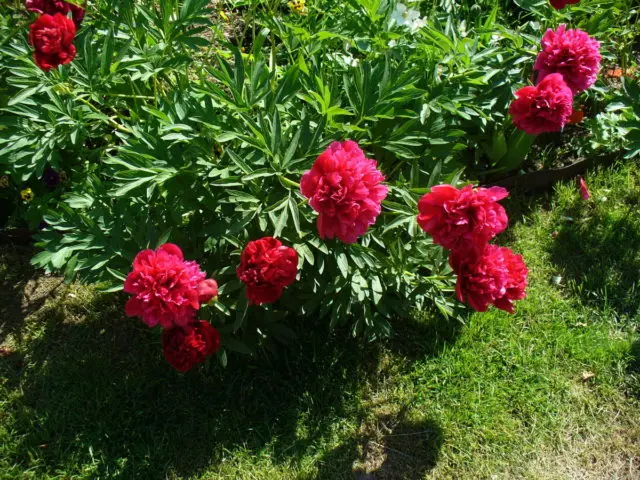
It is better not to plant peonies directly under the trees.
Planting and caring for burgundy peonies
Burgundy peonies are unpretentious flowers in growing. It is enough to choose a good place for them and follow the main rules of care:
- It is recommended to plant peonies in well-lit areas – flowers love sunlight. At the same time, tall buildings should be nearby, which will provide peonies with cover from drafts and strong winds.
- The soil for burgundy peonies should be dry. Before planting peonies, it is necessary to organize drainage on the site and enrich the earth with wood ash, humus and mineral fertilizers.
- Planting of plants in the ground is carried out mainly in September. Spring planting is acceptable but not recommended. The hole for the perennial should be deep, about 80 cm, because its root system is growing rapidly.
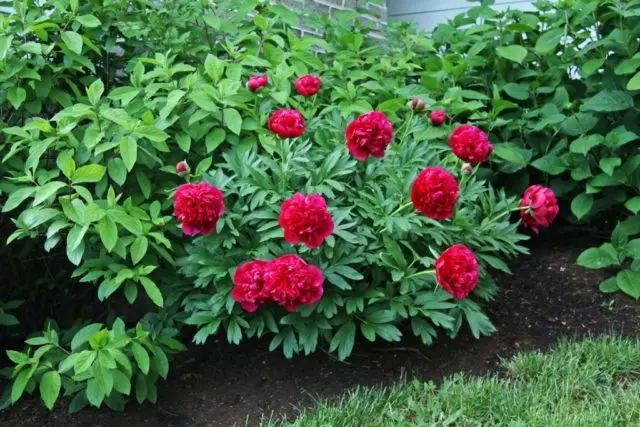
Bushes should be planted near buildings, but in sunny places.
Caring for burgundy peonies is not particularly difficult. It is necessary to water the flower beds weekly, if there is no precipitation, after watering the soil at the roots is loosened and weeds are removed. Flowers are fed three times a season – with nitrogenous fertilizers in early spring, complex minerals during the flowering period, potassium and phosphorus 2 weeks after flowering. When the burgundy buds dry, you will need to cut the flower stalks.
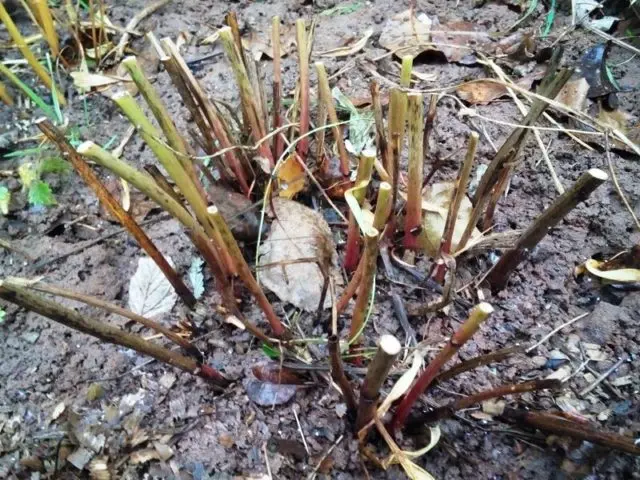
For the winter, bushes are usually cut almost to the ground.
Diseases and pests
Garden burgundy peonies often suffer from fungal diseases and insect pests. You can list some of the most dangerous diseases of perennials:
- Rust. When infected with this disease, the green leaves of the burgundy peony are covered with orange, reddish and brown spots in the form of “pads”. If you do not start treating the disease, the plant will die, and the fungus will spread to neighboring peony bushes.

Rust leaves a characteristic reddish coating on peony leaves.
- Gray mold. The disease affects the entire burgundy peonies – from roots to buds. The first symptom is the wilting of young shoots in spring and the appearance of brown spots at the root neck. After some time, a grayish coating similar to mold appears on the leaves and stems.

Gray rot can develop from the roots
- Mučnistaâ rosa usually manifests itself as a whitish bloom on the upper side of the leaf blades. The disease develops slowly, but affects the decorative effect, and if left untreated, it can lead to the death of the peony bush.

Powdery mildew coats the leaves
- Mosaic. With a viral disease, light spots and separate necrotic areas appear on green leaves, the peony weakens and begins to fade. It is impossible to cure the mosaic; the affected perennial is simply destroyed.

Mosaic – an incurable disease of peonies
The fight against curable fungal diseases is carried out mainly with the help of Bordeaux liquid and specialized solutions – Fundazol and Figon. When treating diseases, all affected parts of the burgundy peony must be removed.
As for pests, the most dangerous for the plant are:
- ants – insects feed on the syrup secreted by the buds, and along the way they can eat the leaves and petals;

Ants eat flower buds
- aphid – buds and shoots suffer from this insect, since the pest feeds on the vital juices of the plant;

Aphids are a dangerous pest of peony bushes because they drink juice from leaves.
- nematodes – worms mainly affect the roots, when infected, it remains only to destroy the bush and disinfect the soil;

It is impossible to save a peony bush from a nematode
- bronze – a beautiful beetle causes damage to burgundy peonies, as it eats petals and leaves.

Bronzovka feeds on petals and can destroy flowers
The fight against aphids, ants and bronzovka is carried out using a soap solution, Aktellik or Fitoverm. During the spring and summer, it is recommended to regularly inspect flowerbeds with peony bushes in order to notice pests in time and immediately start fighting them.
Conclusion
Maroon peonies are very beautiful perennials that require minimal care to grow. There are quite a few varieties of culture, so for each garden you can choose a variety with the optimal height of the bush and the desired shade of flowering.










